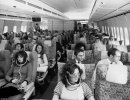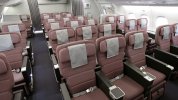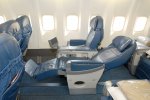I think what you've got (and Virgin Atlantic were first to start the trend) is a bit of "class inflation", the reason being to bring their product into "range" of customers whose employer won't pay for First but will pay the high end of a Business Class fare, and similarly with PE and Business. Eurostar's "Standard Premium" is a railway version of that, sort-of. Which means that I still think (even though not everyone agreed above) that PE is tending towards being what Business was when it was first introduced, and Business towards 1st, and 1st either dropping off the top or being the brand-new Overfinch Range Rover of air travel for the few very rich people who are choosing between it and a private jet.
Virgin Atlantic wasn't the first with Premium Economy - that honour went to EVA Air of Taiwan. What EVA did was very similar to the KLM trial mentioned above; they did use old Business Class seats initially to give it a go. That only lasted so long, and EVA uses specific Premium Economy seats nowadays - as do all the other majors that offer that type of cabin (ie not the KLM/United et al spaced out Economy).
So, apart from those initial embodiments at EVA and KLM, it remains the case that Premium Economy now is more like Economy of old, not Business.
This is quite a famous picture, courtesy of Qantas, showing their Economy Class in the 1970s:

This is their longhaul Economy now - again courtesy of Qantas:

And this is their A380 Premium Economy, courtesy of Airbus:

This fairly clearly shows that their Premium Economy now is closer to their Economy then.
There aren't too many pictures around of older Business Classes, and indeed Qantas was the first airline to offer one in the late 1970s (again actually as a test for full fare Economy ticketholders):

Business Class before flat beds ended up looking like this in most cases, seen here in a Delta-published photograph:

So, when it comes to Premium Economy, it's definitely Economy-of-old, not Business-of-old - even if today's Business Classes are incomparable in hard product terms to Business and First of yore.
As I said earlier, though, in soft product terms, modern First Classes aren't as elevated as Business Class was in the past, so it's more complicated than simple comparisons can ever be.
One other thing to mention, perhaps, is that seats and layouts are often, as much as anything else, a product of the basic architecture of the aircraft themselves. The bar in the nose of the Virgin 747s, for example, was put there to try and make use of space that their choice of Business Class seats and galley locations rendered unusable. Now, just imagine that you have paid an Upper Class fare for a flat bed and some valuable sleep on a short overnight flight from the Eastern Seaboard, and right next to you you've got Jeff and Dave on their way back from the Xerox Extravaganza and wanting to travel like rockstars (from Wikipedia):

This is also why Emirates A380s have a shower in First Class and Etihad has its The Residence - it's because the A380 has a really awkward forward fuselage profile on the upper deck, rendering the areas either side of the grand staircase almost unusable for any normal purpose. It's therefore dead space from a revenue point of view, unless you can do something that at least drives some PR.
It's also why BA had some 747s with Premium Economy behind First but in front of Club - the space in that Zone 2 was better occupied by the dimensions and layout of the PE seats than it could be by the Club beds. Irked loads of folks that PE customers could disembark before Club ones, but the real estate was valuable and the economics drove the layout.
Though if you want to see maximum utilisation of a 747's passenger cabin space, the old all-Economy Corsair layout was probably unbeatable, with the wonderful unique solo seat constituting the first row of the centre bank of seats at the point where the nose narrowed to prohibit any more seats being squeezed in (credit Eric Fortin from AirTeamImages):

I'd say direct to the likes of South East Asia (around the 10-12 hour mark), but I reckon if I was going to Oz I'd probably want a stop-off, ideally for a couple of days rather than straight onto another flight. 24 hours is a long time, even in business or first class.
All that happens is that you get two body clock upsets rather than one; unless you actually want to visit the connecting point and experience the place, it's generally counterproductive to break the journey - in any class.
Don't know if it'd be as special on the few airlines (BA?) that put economy up there, it'd probably be more like a 737 with lower headroom in the window seat.
It's getting on for 30 years since BA had any Economy seats on the upper deck. Certain versions of the 'Classic' 747-136 had 30 economy seats up there; some -236s had 27 and then, when the -436 came along, some of those had 60 seats. They only lasted a few years, though, before all -436 upper decks became fully Club World.
Even at 60 seats, though, it was half the size of a 737 so was quieter and more 'exclusive' and the side bins were a feature of the aircraft, not the cabin (see above for architecture fundamentals) - so window seats in Economy had the bins too, and therefore sat inboard from the fuselage wall and didn't have any particular headroom issues.
One of the main problems with Economy seats up there was in part also the reason for the side bins - the overheads were very small and with that many passengers, there were often issues with storage, even pre-laptops.
Check in @ Terminal 4. It was my first long haul trip, the MEL tags went on, so I believed them!
Oops.
It (sort of) first happened to me in 1986 flying back from Paris. As it was the first time that I'd flown on my own, and the first time that I'd flown on a 'stopping service', I didn't challenge the agent at CDG when she tagged the bag for the first stop on the flight, but of course the bag got off there and I didn't.
Through-checking of bags is a constant course of bother, especially in places like the US, as bags are tagged to final destination but will still come out on the carousel at the first port of entry, for customs clearance, and then they're rechecked with their original tags for the onward flight.







